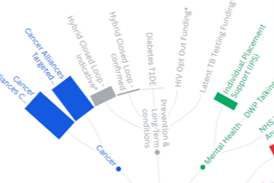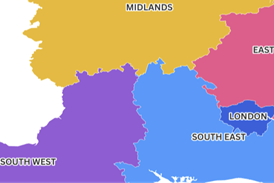By working together and utilising the ‘four Is’, health and care systems can build a fairer system with less unwarranted variation. Andrew Moran explains how this population health management approach could work.
![]()
This is paid-for content from our commercial partners. Find out more
It’s clear that coronavirus affects people disproportionately – those who live in more deprived areas, and those from BAME backgrounds have been disproportionately affected. The reasons for variation in COVID prevalence are not new; the inequalities existed well before COVID and will persist long afterwards. What we need to look at in the coming months and years is how to recover equitably from the pandemic.
Sponsored by
The NHS waiting list in England is currently around 4.7 million and is likely to double by the end of 2021, with NHS Providers believing this will require a multi-year strategy to recover. This represents an opportunity to create a plan to combat systematic unfairness and inequity to create a person-based process, rather than a first-come-first-served approach.
Population health management
Will it be a simple task? No – tackling inequalities and considering individuals’ particular needs will never be an easy undertaking. If we are serious about building a better, fairer health system that combats unwarranted variation, we must work together to reduce the waiting lists through a population health management approach.
This will require health and care systems to work together to better understand their populations, so they can use the information they hold about people and places to plan and commission smarter services that use data to predict, identify and manage risks. Central to the approach are the four Is: infrastructure, intelligence, intervention and incentives. A longitudinal record that brings data together every day is the infrastructure to build your intelligence and interventions upon and plan your incentives.
The difference that population health makes is the data is person-focused
At the system level, each place’s diagnostic capacity can be mapped against need. The information about people receiving their diagnostics in non-acute spaces, community hospitals or advanced GP practices would be available instantly via Health Information Exchange, or in a near-real-time longitudinal population health record, so an MDT can review a person’s RTT pathway virtually and take the next clinical steps. For example, this could include MSK pathways that direct patients to exercise and prehabilitation before surgery, with prioritisation also based on self-reported pain and quality of life.
Combining this data allows the health and care system, place and neighbourhood to understand how people use resources, and the inequity that exists within their groups and neighbours. Cerner clients have used data linked to HealtheIntent® – the Cerner population health platform – to identify that those with learning disabilities are 6.36 times more likely to be admitted with flu. It also shows that those with chronic kidney disease are 2.5 times more likely to be admitted with COVID as priority cohorts for vaccination, and multi-morbidity increases risk. Those with four-or-more long-term conditions are at 40 per cent risk of admission compared to those with one, who are at 15 per cent.
Data science can begin to segment the figures to show people with mental health conditions are the highest users of urgent care, with the greatest levels of smoking and alcohol dependency. Some 60 per cent of schizophrenia patients have more than one condition – most often asthma or diabetes – to which fewer than half meet the best practice guides.
The population can be analysed by age, sex, risk, condition, first language spoken, deprivation, ethnicity, social care package, RTT priority group, and weeks waited. Finding the people who have historically been underserved, presented late and have the poorest outcomes, and addressing their issues is a priority.
The difference that population health makes is the data is person-focused. You can identify those most at-risk within the ICS to a granular level and involve individuals in the decision-making process. You can prioritise waiting lists and those in greatest need, and put the intelligence into redesigned staff workflows so that they become outcomes-focused, not activity-driven.
At Cerner, we believe this is our part to play: to reveal unwarranted variation hidden within the data and signpost best practice to provide clients with the tools for recovery and the learning to share, and putting it to practical use.
It is not acceptable to leave inequality unaddressed in the recovery – change is possible, better is possible, so let’s build on the best aspects of health and care we have experienced during the pandemic.




























